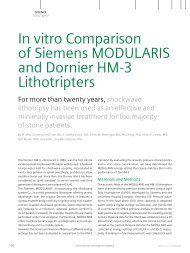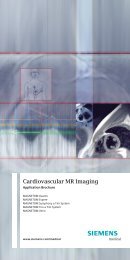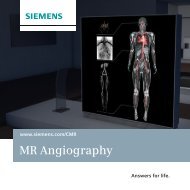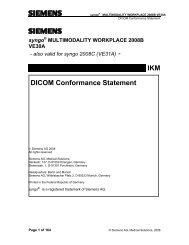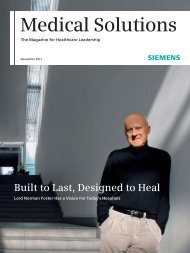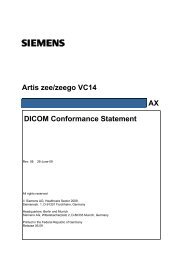Image-guided solutions for interventional oncology - Siemens ...
Image-guided solutions for interventional oncology - Siemens ...
Image-guided solutions for interventional oncology - Siemens ...
- No tags were found...
Create successful ePaper yourself
Turn your PDF publications into a flip-book with our unique Google optimized e-Paper software.
<strong>Image</strong>-<strong>guided</strong> <strong>solutions</strong> <strong>for</strong> <strong>interventional</strong> <strong>oncology</strong>Clinical caseswww.siemens.com / healthcare
Minimally invasive, maximally effective.<strong>Image</strong>-<strong>guided</strong> <strong>solutions</strong> <strong>for</strong> <strong>interventional</strong> <strong>oncology</strong> from <strong>Siemens</strong>.Cancer cases worldwide could increase as much as 50% by the year 2020. Many of these patients will developmetastases and tumors, which, <strong>for</strong> the most part, are not surgically treatable. Until now.Within recent years, minimally invasive therapies have emerged <strong>for</strong> treating isolated tumors. The rapidly growingfield known as <strong>interventional</strong> <strong>oncology</strong> is changing the image of cancer care with procedures such as transarterialchemoembolization (TACE), selective internal radiation therapy (SIRT) and radiofrequency ablation (RFA).2
Hepatic Arterial ChemoembolizationCourtesy of Thomas J. Vogl, M.D.Diagnostic and Interventional Radiology,Johann Wolfgang Goethe University,Frankfurt/M, GermanyPatient historyA 67-year-old maleDiagnosisLiver tumor metastasisTreatmentThe tumor metastasis already measured5 x 5 cm in the right lobe of the liver and originatedfrom colorectal carcinoma. A decisionwas made <strong>for</strong> chemoembolization. There<strong>for</strong>ea 5 French sidewinder catheter was positionedin the celiac trunk and a 3 French microcatheterwas selected <strong>for</strong> the right hepaticartery.5
Selective Pulmonary Artery ChemoembolizationCourtesy of Thomas J. Vogl, M.D.Diagnostic and Interventional Radiology,Johann Wolfgang Goethe University,Frankfurt/M, GermanyPatient history56-year-old maleDiagnosisLeft lung metastasesTreatmentThe metastases in the left lung originatedfrom colorectal carcinoma. Selective left pulmonarychemoembolization was per<strong>for</strong>medby using a 5 French pigtail catheter.6
Transarterial Chemoembolization of Hepatocellular CarcinomaCourtesy of Kiang-Hiong Tay, M.D., PhD,Peter Chu-Chun Yang, Principal RadiographerInterventional Radiology Centre,Department of Diagnostic Radiology,Singapore General Hospital, SingaporeDiagnosisHypervascular hepatocellular carcinoma inthe right hepatic lobeTreatmentTo visualize the HCC, a selective right hepaticartery injection was per<strong>for</strong>med using syngoLarge Volume DynaCT and a 8-second DR protocol.After the TACE treatment a post syngoDynaCT image demonstrated the intense lipiodoluptake by the right lobe HCC, indicatingadequate treatment.7
SIRT - a new apporach in minimally invasive tumor therapyRadioembolization (SIRT) is a relatively newpalliative treatment option <strong>for</strong> primary andsecondary liver tumors which combines theeffects of interstitial high-dose radiotherapyand arterial micro-embolization. The resinmicrospheres (SIR-Spheres®) are labelled withthe isotope yttrium 90. The microspheresserve as a radiation source and are infusedinto the hepatic arteries, resulting in theselected targeting of very high doses ofradiation to metastases via their arterialblood supply.Tobias Jakobs, M.D.,Department of RadiologyLudwig Maximilian University of Munich,Campus Grosshadern, Munich, GermanyDuring SIRT prophylactic embolization ofthe gastroduodenal artery is done routinely.Furthermore, to avoid ectopic implantationof yttrium 90 microspheres into aberrantvisceral vessels, a careful and meticulousangiography of the hepatic vasculature ismandatory. However, the differentiationbetween intrahepatic vessels and vesselsleading into the GI region is not easy in allcases, especially where extensive tumorburden is present or in patients whopreviously underwent surgical resection ofliver tumors. To avoid distribution or reflux ofmicrospheres outside the liver, identificationand occlusion of those vessels is crucial <strong>for</strong>preventing side effects (e.g. gastric ulcers,pancreatitis skin ulcerations) in the patient.Courtesy of T. Jakobs, M. D.University of Munich, Germany10
Selective Internal Radiation Therapy (SIRT)Courtesy of Tobias Jakobs, M.D.,Department of RadiologyLudwig Maximilian University of Munich,Campus GrosshadernMunich, GermanyPatient history40-year-old female with otherwisetreatment-refractory liver metastases frombreast cancer.DiagnosisLiver metastasesTreatmentA DSA image of the left hepatic artery wasper<strong>for</strong>med. Arterial vessels are displayedreaching far to the left abdominal wall, there<strong>for</strong>econspicuous <strong>for</strong> collateralization to thestomach. A Large Volume syngo DynaCT hasbeen per<strong>for</strong>med, which confirms that the suspiciousarteries are all within the left liverlobe and no contrast uptake outside the livercan be detected. This increases the confidenceof the treating radiologist that an injectionof the yttrium 90 microspheres from thiscatheter position would not result in accidentaldeposition of the microspheres in thestomach wall.11
Selective Internal Radiation Therapy (SIRT)Courtesy of Tobias Jakobs, M.D.,Department of RadiologyLudwig Maximilian University of Munich,Campus GrosshadernMunich, GermanyDiagnosisTreatment-refractory liver metastases from aNeuroendocrine Tumor (NET)TreatmentA superselective injection into the segmentalartery supplying liver segment 4 was per<strong>for</strong>med.A conspicuous vessel was identifiedshowing a course which might reflect a falci<strong>for</strong>martery. To rule out a falci<strong>for</strong>m artery aLarge Volume syngo DynaCT was per<strong>for</strong>med.The axial and coronal re<strong>for</strong>mats clearly demonstratethat the suspicious vessel is not thefalci<strong>for</strong>m artery and no contrast uptake isseen within the abdominal wall.12
Selective Internal Radiation Therapy (SIRT)Courtesy of Tobias Jakobs, M.D.,Department of RadiologyLudwig Maximilian University of Munich,Campus GrosshadernMunich, GermanyPatient history69-year-old maleDiagnosisIntrahepatic cholangiocellular carcinomaTreatmentA selective injection into the left hepatic arterywas per<strong>for</strong>med in a patient who previouslyunderwent right lobe hemi-hepatectomy.No suspicious vessel was identified.However, Large Volume syngo DynaCT revealedcontrast uptake within the lesser curvatureof the stomach. There<strong>for</strong>e the catheterposition was altered and the tip was placedmore distally. The following syngo DynaCT revealedthat there was no more evidence <strong>for</strong>ectopic contrast uptake in the stomach butcomplete coverage of the tumors. This wasconfirmed by SPECT-CT after injection of technetium-99mmacroaggregated albumin.13
Radioembolization of a Metastatic Liver CarcinomaCourtesy of John Fritz Angle, M.D,Leanne Doré Lessley, Alan H. Matsumoto, M.D.Department of Interventional Radiology,University of Virgina,Charlottesville, VA, USAPatient history60-year-old male with liver predominant metastaticcarcinoid. Patient previously hadbland embolization but now has new diseasein segments IV and VIII. Patient referred <strong>for</strong>yttrium-90 (Y90) microsphere treatment ofthe right lobe.Hier vielleicht einen Text in dem der Mousover erwähnt wird?Place <strong>for</strong> a short message about mouse over?DiagnosisCross-sectional imaging and planning angiogramdemonstrated multiple hypervascularmasses with a dominant mass in the rightlobe. Right lobe liver volume was calculatedfrom a Large Volume syngo DynaCT in an Artiszeego <strong>interventional</strong> suite.TreatmentY90 microsphere administration to the righthepatic lobe via a right hepatic artery injection.syngo iFlow analysis of matching DSAacquisitions be<strong>for</strong>e and after Y90 embolizationdemonstrates a relative decrease in perfusionwithin the large right lobe tumor withno visible change in perfusion of the normalportions of liver. In the future, syngo iFlowmay help <strong>interventional</strong> radiologists assessthe distribution of Y90 to tumor and normalliver.syngo Sagittal DynaCT slice orientationimage showing intense lipiodol uptake14
On account of certain regional limitations of salesrights and service availability, we cannot guaranteethat all products included in this brochure areavailable through the <strong>Siemens</strong> sales organizationworldwide. Availability and packaging may vary bycountry and are subject to change without prior notice.Some / All of the features and products describedherein may not be available in the United States orother countries.The in<strong>for</strong>mation in this document contains generaltechnical descriptions of specifications and optionsas well as standard and optional features that do notalways have to be present in individual cases.<strong>Siemens</strong> reserves the right to modify the design,packaging, specifications and options describedherein without prior notice. Please contact your local<strong>Siemens</strong> sales representative <strong>for</strong> the most currentin<strong>for</strong>mation.In the interest of complying with legal requirementsconcerning the environmental compatibility of ourproducts (protection of natural resources and wasteconservation), we recycle certain components. Usingthe same extensive quality assurance measures as <strong>for</strong>factory-new components, we guarantee the quality ofthese recycled components.Note: Any technical data contained in this documentmay vary within defined tolerances. Original imagesalways lose a certain amount of detail when reproduced.For product accessories see:www.siemens.com /medical-accessoriesGlobal Business Unit<strong>Siemens</strong> AGMedical SolutionsAngiography, Fluoroscopic and Radiographic Systems<strong>Siemens</strong>strasse 1DE-91301 ForchheimGermanyTelephone +49 9191 18-0www.siemens.com/healthcareGlobal <strong>Siemens</strong>Healthcare Headquarters<strong>Siemens</strong> AGHealthcare SectorHenkestrasse 12791052 ErlangenGermanyTelephone: +49 9131 84-0www.siemens.com/healthcareLegal Manufacturer<strong>Siemens</strong> AGWittelsbacherplatz 2DE-80333 MuenchenGermanyGlobal <strong>Siemens</strong> Headquarters<strong>Siemens</strong> AGWittelsbacherplatz 280333 MuenchenGermanywww.siemens.com/healthcarePDF only | | © 02.2010, <strong>Siemens</strong> AG15


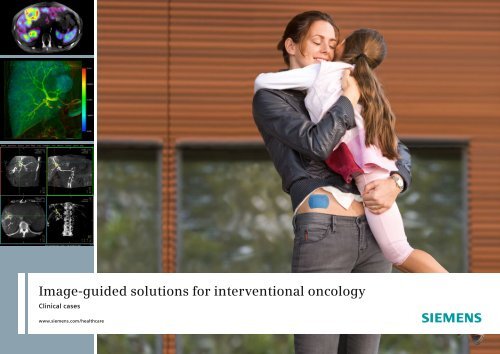

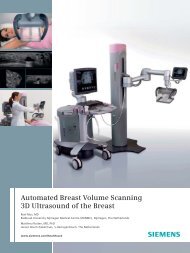
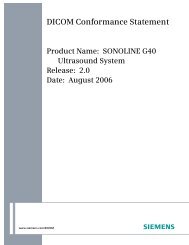
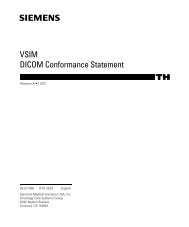

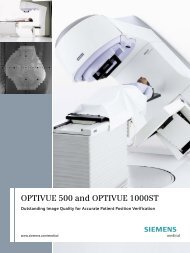
![WalkAway plus Technical Specifications [41 KB] - Siemens Healthcare](https://img.yumpu.com/51018135/1/190x253/walkaway-plus-technical-specifications-41-kb-siemens-healthcare.jpg?quality=85)
